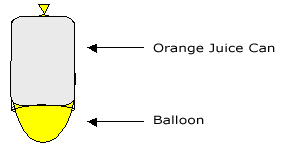Air Pressure Curriculum
Section 2—Lesson 3: Passive Causal Agents and the Omnidirectional Nature of Air Pressure
Lesson Plan
Materials
- Balloon, 1 per class
- Orange juice can, 1 per class
Prep Step
- Review the lesson plan, background information, and understanding goals.
- Remove the bottom from the orange juice can.
Analyze Thinking
Step 1: Gathering Current Ideas
Set a book on the table at the front of the class. Ask: "How does air pressure affect this book? Take a moment and write your ideas on a piece of paper or draw a model."
Note to Teacher: Walk around and observe the students as they write their ideas and draw their models. In particular, note models that show a "pushing down" theory of air pressure. Have these models available for the RECAST activity below.
Have several students share their ideas with the class verbally or put their models on the board.
RECAST Thinking
Step 2: Making Predictions About the Effects of Air Pressure
Present the balloon and the orange juice can. Blow up the balloon into the orange juice can until it extends out the bottom of the can.

Have students predict what air pressure will do to the balloon when you turn the can over. (Responses might include that nothing will happen, or that air pressure pushes downward on the balloon, squishing it down.)
Step 3: Considering Evidence for the Omnidirectional Behavior of Air Pressure
After you have collected students' predictions, slowly turn the can upside down and have students observe what happens. (Nothing happens.)
Have students consider why this is a problem for the "pushing down only" theory of air pressure. Ask: "If air pressure only pushed downward on objects, what would have happened to the balloon?" (The balloon would have shifted and squished out the other end of the can.)
Explore Causality
Step 4: Considering Which Model Best Explains the Evidence
Discuss unidirectional versus omnidirectional causality with your students. Put the following models on the board:
 |
 |
Ask students:
- Is this what the balloon and can looked like? (No, the balloon kept its shape.)
- If these diagrams illustrate what the balloon should have looked like if pressure only existed in a downward direction, and the balloon didn't look like this, what can you conclude from this activity? (The unidirectional model did not explain what happened.)
- Do the results support any other model? (Yes, an omnidirectional model that says air pressure exists in all directions equally.)
Relate what students observe to the idea of passive causes. Explain that the unidirectional model fits with our expectations about causes, that they actively do something. In the unidirectional model, the cause is a force that is pushing down on the balloon. We expect to see a change in a cause and effect relationship. However, causes don't always work that way. Sometimes there is no observable change. Causes don't appear to be "doing" anything, even though they may be maintaining the status quo. Air pressure is passive in this way. It pushes in all directions at once (is omnidirectional) so unless we unbalance it in some way, we may not realize that it is doing anything.
In Section 1, students lifted a table using balloons. Remind students about this activity. What does the outcome suggest for the unidirectionality or omnidirectionality of air pressure? If air pressure only pushed downward, could the air in the balloons push the table upwards?
Review, Extend, Apply
Step 5: Revisiting Students' Earlier Models
Have students go back to the models they drew in Step 1. Ask:
- Based on what you learned in class today, did you model unidirectional or omnidirectional causality in your drawing of the book on the table?
- What should a model of air pressure look like with a book on a table? (The model should show the book on the table with pressure existing around the book in all directions equally.)


